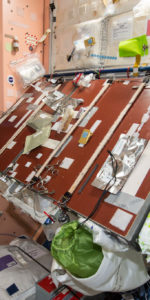
Pluto, a tiny frigid world in the distant outskirts of the Solar System, has been full of surprises, as first revealed by the New Horizons spacecraft back in July 2015. Expected to be mostly a cold, geologically dead place, it has instead been shown to be quite the opposite. Yes, it’s bitterly cold of course, but New Horizons found ample evidence that it has also been geologically active in the past and in some ways still is. With tall mountains of solid water ice, ancient riverbeds carved by nitrogen rivers, vast plains, still-flowing glaciers of nitrogen ice, and possible ice volcanoes, Pluto is a wondrous world indeed. Another new finding makes it even more remarkable: evidence for a subsurface ocean of water. This had also been reported on previously by AmericaSpace, but the new update strengthens the case.
A water ocean on Pluto? How is that even possible? Well, first it is a subsurface ocean, similar to ones on Jupiter’s moon Europa and Saturn’s moon Enceladus, among others. Temperatures on the surface are much, much too cold for liquid water (water ice is hard as rock and at lower latitudes near the equator, temperatures on Pluto can reach almost minus 400 degrees Fahrenheit), but deep below the surface seems to be a different story.
The findings are part of an update on Pluto discoveries published in UANews and Nature. The focus is on Sputnik Planitia, the large plain of nitrogen ice which makes up half of Pluto’s now-famous “heart” feature. Data from New Horizons shows that Sputnik Planitia appears to be in its present location on the surface due to an accumulation of ice which caused the dwarf planet to “roll over.” This created tension and cracks in the surface which point to a subsurface ocean of water, according to scientists.
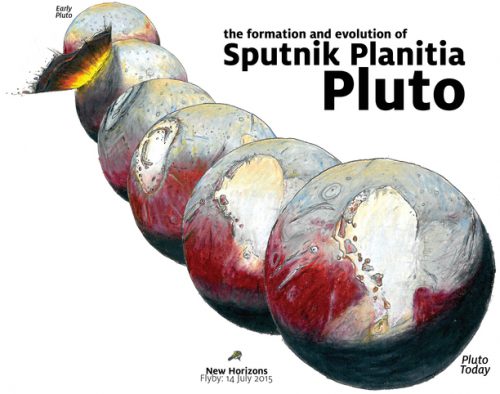
According to James Keane, a doctoral student at the University of Arizona’s Lunar and Planetary Laboratory: “There are two ways to change the spin of a planet. The first – and the one we’re all most familiar with – is a change in the planet’s obliquity, where the spin axis of the planet is reorienting with respect to the rest of the Solar System. The second way is through true polar wander, where the spin axis remains fixed with respect to the rest of the Solar System, but the planet reorients beneath it.”
The scenario involves an accumulation of so much nitrogen ice in that region that Pluto was thrown “off kilter, much like a spinning top with a wad of gum stuck to it.” This process is called true polar wander.
“Each time Pluto goes around the Sun, a bit of nitrogen accumulates in the heart,” Keane said. “And once enough ice has piled up, maybe a hundred meters thick, it starts to overwhelm the planet’s shape, which dictates the planet’s orientation. And if you have an excess of mass in one spot on the planet, it wants to go to the equator. Eventually, over millions of years, it will drag the whole planet over.”
“I think this idea of a whole planet being dragged around by the cycling of volatiles is not something many people had really thought about before,” Keane added.
To determine the interior composition of Pluto, researchers used observations made during New Horizons’ flyby last year and combined them with computer models. This allowed them to take a surface feature such as Sputnik Planitia, shift it around on the planet’s surface, and see what effect if any that had on the planet’s spin axis.
Polar wander also occurred with the Moon and Mars, but billions of years ago.
“On Pluto, those processes are currently active,” Keane said. “Its entire geology – glaciers, mountains, valleys – seems to be linked to volatile processes. That’s different from most other planets and moons in our Solar System.”
The computer simulations also predicted cracks and faults in Pluto’s surface in the exact locations that New Horizons later discovered them. These tectonic faults are a major sign of a subsurface ocean on Pluto.
“It’s like freezing ice cubes,” Keane noted. “As the water turns to ice, it expands. On a planetary scale, this process breaks the surface around the planet and creates the faults we see today.”
These findings indicate that Pluto has been, and still is, much more active than previously thought possible.
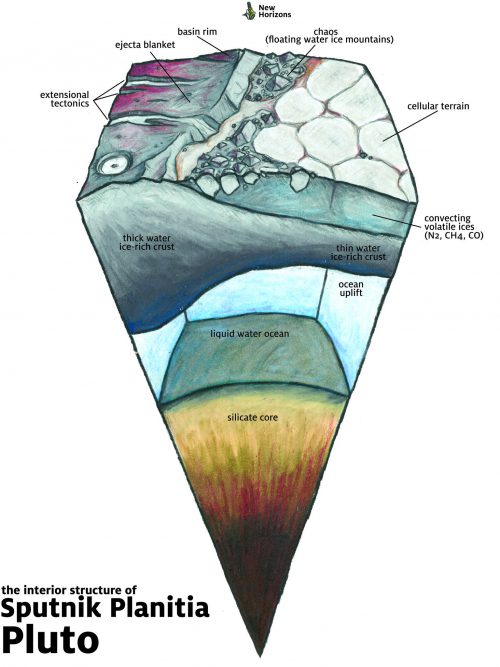
“Before New Horizons, people usually only thought of volatiles in terms of a thin frost veneer, a surface effect that might change the color, or affect local or regional geology,” Keane said. “That the movement of volatiles and shifting ice around a planet could have a dramatic, planet-moving effect is not something anyone would have predicted.”
AmericaSpace also spoke with Alan Stern, principal investigator of the New Horizons mission about the new findings and what they mean:
AS: Could Pluto’s ocean be similar to the oceans on Europa and Enceladus for example or notably different?
Stern: “Yes, the ocean on Pluto could be quite similar to those of icy moons since the same kinds of geological mechanisms are involved with the same kind of heating process.”
AS: How close would it be to the surface?
Stern: “It is not known yet how near to the surface the ocean may be, as the scientific models have a wide range of parameters. It could be several hundreds of miles or shallower. We would really need a follow-up mission to pin down the depth of the ocean.”
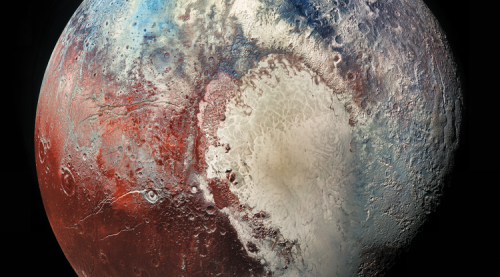
AS: Could the ocean be potentially habitable?
Stern: “It certainly could be as long as it is warm enough. One other major criteria would be the presence of harmful toxins in the ocean, such as hydrogen peroxide.”
AS: Could there be a connection to possible cryovolcanism (ice volcanoes)?
Stern: “Yes there could be. Cryovolcanism in the recent past could very well be connected to the ocean below. New Horizons did find possible cryovolcanoes on Pluto’s surface.”
AS: Could other KBOs also have oceans?
Stern: “Yes, they could. Dwarf planets such as Sedna and Ceres could very well have subsurface oceans as well. These oceans may be quite common and Earth might be unusual for having its ocean on the surface instead of below ground.”
Stern made a point about how we don’t yet understand how a lot of these processes on Pluto actually work; a follow-up orbiter mission will be required, and he is confident it can happen in his lifetime.
Stern also noted that Pluto could be a quite different place a few billion years from now. As the Sun gradually transforms into an expanding red giant later in its life, the Earth would be incinerated, but Pluto would become warm enough to become habitable. It and other Kuiper Belt objects would have the same kind of temperatures that Earth has now. The ices would melt and Pluto could then even have water on its surface, since as the Sun expands the habitable zone would be pushed farther and farther out. Future Pluto may be a lot more Earth-like than it is now.
Present-day Pluto, however, is an enigmatic little world, with many surprises for planetary scientists. It has shown that just because a rocky body orbits so far from the Sun in the cold outer reaches of the Solar System, doesn’t mean it must be geologically dead. Indeed, such worlds can be very much alive, and the existence of subsurface oceans indicates a similarity with other icy moons closer to the Sun. The study of Pluto also provides clues to the nature of other rocky and icy bodies in the Kuiper Belt, known as Kuiper Belt Objects (KBOs).
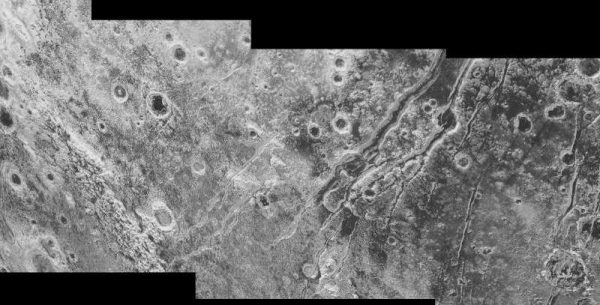
On Jan. 1, 2019, New Horizons will fly past the small KBO called 2014 MU69. 2014 MU69 is much smaller than Pluto, only about 13 to 25 miles (21 to 40 kilometers) across, but New Horizons will pass by at a distance of only about 1,900 miles (3,000 kilometers), four times closer than the Pluto flyby. As previously noted by Stern:
“The Kuiper Belt is a rich scientific frontier. Its exploration has important implications for better understanding comets, the origin of small planets, the Solar System as a whole, the solar nebula, and dusty Kuiper Belt-like disks around other stars, as well as for studying primitive material from our own Solar System’s planet formation era. The exploration of the Kuiper Belt and KBOs like MU69 by New Horizons would transform Kuiper Belt and KBO science from a purely astronomical pursuit, as it is today, to a geological and geophysical pursuit.”
See also the two new Nature papers, ‘Reorientation and faulting of Pluto due to volatile loading within Sputnik Planitia‘ and ‘Reorientation of Sputnik Planitia implies a subsurface ocean on Pluto‘ for more details (purchase or subscription). More information about the New Horizons mission is available here.
Follow our New Horizons mission page for regular updates.
Be sure to “Like” AmericaSpace on Facebook and follow us on Twitter: @AmericaSpace
Missions » New Horizons »




